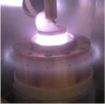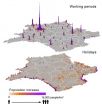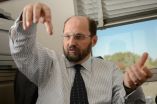(Press-News.org) Recent fusion experiments on the DIII-D tokamak at General Atomics (San Diego) and the Alcator C-Mod tokamak at MIT (Cambridge, Massachusetts), show that beaming microwaves into the center of the plasma can be used to control the density in the center of the plasma, where a fusion reactor would produce most of its power. Several megawatts of microwaves mimic the way fusion reactions would supply heat to plasma electrons to keep the "fusion burn" going.
The new experiments reveal that turbulent density fluctuations in the inner core intensify when most of the heat goes to electrons instead of plasma ions, as would happen in the center of a self-sustaining fusion reaction. Supercomputer simulations closely reproduce the experiments, showing that the electrons become more turbulent as they are more strongly heated, and this transports both particles and heat out of the plasma.
"We are beginning to uncover the fundamental mechanisms that control the density, under conditions relevant to a real fusion reactor," says Dr. Darin Ernst, a physicist at the Massachusetts Institute of Technology, who led the experiments and simulations, together with co-leaders Dr. Keith Burrell (General Atomics), Dr. Walter Guttenfelder (Princeton Plasma Physics Laboratory), and Dr. Terry Rhodes (UCLA).
The experiments were conducted by a team of researchers as part of a National Fusion Science Campaign. This new program enables research on one fusion experiment to be expanded to device another with complementary instrumentation and capabilities. "The National Campaign has increased the impact of our work, with added benefit to the fusion program," says Dr. Ernst. "Comparing Alcator C-Mod and DIII-D tests our new predictions that particle collisions strongly reduce this type of turbulence. The collision rate varies by a factor of ten between the two machines," says Ernst.
The experiments and simulations suggest that trapped electron turbulence becomes more important under the conditions expected in self-heated fusion reactors. The structure of the simulated turbulence during the electron heating is shown at right. The simulations closely matched detailed measurements of the actual turbulence in the 20cm diameter inner core. "We discovered sheared flows also drive turbulence in the inner plasma core, but as we approached conditions where mainly the electrons are heated, the usual plasma flow is reduced and pure trapped electron turbulence begins to dominate," says Dr. Guttenfelder, who did the supercomputer simulations for the DIII-D experiments, along with Dr. Andris Dimits (LLNL). Measurements revealed a band of fluctuations, separated by a constant frequency interval, like harmonics in a musical note. "These new coherent fluctuations appear to be consistent with the basic trapped electron instability that grows stronger during heating, " says Dr. Rhodes.
In a self-heated fusion reactor, fusion reactions produce very energetic alpha particles that collide with electrons as they move through the plasma. The collisions heat the electrons by imparting random thermal motion. The electrons in turn collide with and heat cooler deuterium and tritium fuel ions to fusion temperatures. However, turbulent eddies can swirl the particles and energy away from the hot core toward the cooler edge, where they eventually are lost to the walls of the chamber.
These experiments are part of a larger systematic study of turbulent energy and particle loss under fusion-relevant conditions. "It's important to understand what drives the turbulence, and how it can be controlled and minimized, to find new ways of operating tokamaks that exploit that knowledge," says Dr. Burrell. By comparing detailed turbulence measurements with simulations, researchers hope to understand how turbulence controls the core temperature under fusion conditions.
INFORMATION:
This material is based upon work supported in part DE-FC02-08ER54966, by the U.S. Department of Energy, Office of Science, Office of Fusion Energy Sciences, using the DIII-D National Fusion Facility, a DOE Office of Science user facility, under Awards DE-FC02-08ER54966, DE-FC02-04ER54698, DE-FC02-04ER54698, DE-AC02-09CH11466, DE-FG02-08ER54984, and DE-AC52-07NA27344, DE-AC02-5CH11231 (NERSC). The computer simulations were supported by an Advanced Leadership Computing Challenge Award at the Naitonal Energy research Supercompting Center (NERSC) from the Office of Advanced Scientific Computing Research.
Contacts:
D. Ernst, MIT (617) 253-0478, dernst@psfc.mit.edu
K. Burrell, General Atomics (858) 455-2278, burrell@fusion.gat.com
W. Guttenfelder, PPPL (609) 243-2426, wgutten@pppl.gov
T. Rhodes, UCLA (858) 455 2437, trhodes@ucla.edu
A. Dimits, LLNL (925) 422-0211, dimits1@llnl.gov
Abstracts:
CO5.00002
Controlling DIII-D QH-Mode Particle and Electron Thermal Transport with ECH
Speaker: D. R. Ernst (MIT)
2:12 PM–2:24 PM, Monday, October 27, 2014, Galerie 2/3
Using radio waves to control the density in a fusion plasma
News from the 2014 APS Division of Plasma Physics Meeting
2014-10-28
ELSE PRESS RELEASES FROM THIS DATE:
Helping general electric upgrade the US power grid
2014-10-28
When researchers at General Electric Co. sought help in designing a plasma-based power switch, they turned to the U.S. Department of Energy's (DOE) Princeton Plasma Physics Laboratory (PPPL). The proposed switch, which GE is developing under contract with the DOE's Advanced Research Projects Agency-Energy, could contribute to a more advanced and reliable electric grid and help to lower utility bills.
The switch would consist of a plasma-filled tube that turns current on and off in systems that convert the direct current (DC) coming from long-distance power lines to the ...
European consensus on methodological recommendations for clinical studies in rare cancers
2014-10-28
One out of every five new cancer patients is diagnosed with a rare cancer, yet the clinical evidence needed to effectively treat these rare cancer patients is scarce. Indeed, conventional cancer clinical trial methodologies require large numbers of patients who are difficult to accrue in the situation of rare cancers. Consequently, building clinical evidence for the treatment of rare cancers is more difficult than it is for frequent cancers.
Dr. Jan Bogaerts, EORTC Methodology Vice Director, points out, "For rare cancers, we need alternative ways to conceive study designs ...
Lack of A level maths leading to fewer female economists
2014-10-28
A study by the University of Southampton has found there are far fewer women studying economics than men, with women accounting for just 27 per cent of economics students, despite them making up 57 per cent of the undergraduate population in UK universities.
The findings suggest less than half as many girls (1.2 per cent) as boys (3.8 percent) apply to study economics at university, while only 10 per cent of females enrol at university with an A level in maths, compared to 19 per cent of males.
"This underrepresentation of women economics degrees could have major implications ...
Physicists' simple solution for quantum technology challenge
2014-10-28
A solution to one of the key challenges in the development of quantum technologies has been proposed by University of Sussex physicists.
In a paper published today (28 October) in Nature Communications, Professor Barry Garraway and colleagues show how to make a new type of flexibly designed microscopic trap for atoms.
Quantum technology devices, such as high-precision sensors and specialised superfast computers, often depend on harnessing the delicate interaction of atoms. But the methods for trapping these tiny particles are hugely problematic because of the atoms' ...
Technique uses bacteria's own CRISPR-Cas system to turn off gene
2014-10-28
Researchers from North Carolina State University have developed a technique that co-opts an immune system already present in bacteria and archaea to turn off specific genes or sets of genes – creating a powerful tool for future research on genetics and related fields.
"This should not only expedite scientific discovery, but help us better engineer microbial organisms to further biotechnology and medicine," says Dr. Chase Beisel, an assistant professor of chemical and biomolecular engineering at NC State and senior author of a paper on the work. "For example, this ...
Researchers prove accuracy of mobile phone population mapping
2014-10-28
A study by an international team, including the University of Southampton, has shown population maps based on anonymous mobile phone call record data can be as accurate as those based on censuses.
Their findings show maps made using mobile records are detailed, reliable and flexible enough to help inform infrastructure and emergency planners; particularly in low income countries, where recent population density information is often scarce.
Southampton geographer and senior author on the study, Dr Andy Tatem, says: "Proving the resilience and accuracy of using mobile ...
Self-reported sleep disturbances are linked to higher risk for Alzheimer's disease in men
2014-10-28
In a new study, researchers from Uppsala University demonstrate that elderly men with self-reported sleep disturbances run a higher risk of developing Alzheimer's disease than men without self-reported sleep disturbances. The results are published in the scientific journal Alzheimer's & Dementia.
The researchers followed more than 1,000 men, who were initially 50 year old, between the years 1970 and 2010. The results of the study show that self-reported sleep disturbances were linked to an increased risk for Alzheimer's disease during the 40-year follow-up period, particularly ...
The early chimp gets the fig
2014-10-28
This news release is available in German.
How do our close relatives, the chimpanzees, acquire sufficient food when times are lean? By studying wild chimpanzees in the Taï National Park in Côte d'Ivoire researchers of the Max Planck Institute for Evolutionary Anthropology in Leipzig, Germany, provide a clear example of how great apes can acquire extra energy needed to maintain large, costly brains. They show that chimpanzees make their sleeping nests more en route to breakfast sites containing fruits that are more competed for by other daytime fruit-eaters ...
Lessons learned from SARS pandemic should inform current contagion protocols
2014-10-28
In 2003, a novel coronavirus caused a pandemic that affected 26 countries. Severe Acute Respiratory Syndrome (SARS) was most prevalent in Asia; the number of cases in Singapore was second only to China.
In an article published in the American Journal of Roentgenology (AJR), a group of radiologists in Singapore outline the ways in which both medical facilities and practitioners there have incorporated lessons learned from the SARS pandemic.
"The pandemic served as a wake-up call for the medical services, which had to respond and reorganize quickly to meet the rapidly ...
Do financial experts make better investments?
2014-10-28
EAST LANSING, Mich. --- Financial experts do not make higher returns on their own investments than untrained investors, according to research by a Michigan State University business scholar.
The first-of-its-kind study analyzed the private portfolios of mutual fund managers and found the managers were surprisingly unsuccessful at outperforming nonprofessional investors. The findings suggest average investors might be better served to handle their own portfolios rather than pay the often-high fees charged by mutual fund managers, said Andrei Simonov, associate professor ...
LAST 30 PRESS RELEASES:
Scientists to ‘spy’ on cancer- immune cell interactions using quantum technology breakthrough
Tech savvy users have most digital concerns
Making lighter work of calculating fluid and heat flow
Normalizing blood sugar can halve heart attack risk
Lowering blood sugar cuts heart attack risk in people with prediabetes
Study links genetic variants to risk of blinding eye disease in premature infants
Non-opioid ‘pain sponge’ therapy halts cartilage degeneration and relieves chronic pain
AI can pick up cultural values by mimicking how kids learn
China’s ecological redlines offer fast track to 30 x 30 global conservation goal
Invisible indoor threats: emerging household contaminants and their growing risks to human health
Adding antibody treatment to chemo boosts outcomes for children with rare cancer
Germline pathogenic variants among women without a history of breast cancer
Tanning beds triple melanoma risk, potentially causing broad DNA damage
Unique bond identified as key to viral infection speed
Indoor tanning makes youthful skin much older on a genetic level
Mouse model sheds new light on the causes and potential solutions to human GI problems linked to muscular dystrophy
The Journal of Nuclear Medicine ahead-of-print tip sheet: December 12, 2025
Smarter tools for peering into the microscopic world
Applications open for funding to conduct research in the Kinsey Institute archives
Global measure underestimates the severity of food insecurity
Child survivors of critical illness are missing out on timely follow up care
Risk-based vs annual breast cancer screening / the WISDOM randomized clinical trial
University of Toronto launches Electric Vehicle Innovation Ontario to accelerate advanced EV technologies and build Canada’s innovation advantage
Early relapse predicts poor outcomes in aggressive blood cancer
American College of Lifestyle Medicine applauds two CMS models aligned with lifestyle medicine practice and reimbursement
Clinical trial finds cannabis use not a barrier to quitting nicotine vaping
Supplemental nutrition assistance program policies and food insecurity
Switching immune cells to “night mode” could limit damage after a heart attack, study suggests
URI-based Global RIghts Project report spotlights continued troubling trends in worldwide inhumane treatment
Neutrophils are less aggressive at night, explaining why nighttime heart attacks cause less damage than daytime events
[Press-News.org] Using radio waves to control the density in a fusion plasmaNews from the 2014 APS Division of Plasma Physics Meeting




